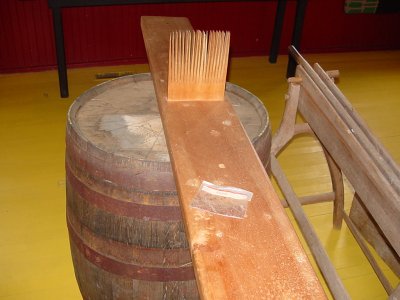|

Linen, the fabric made from flax, is one of the oldest fabrics in the world and was preferred by many ancient civilizations. The process used to prepare flax today has not varied much from the process used by the Egyptians four to five thousand years ago.
The flax plant grows about two to three feet high. It has a stem that branches out at the top, smooth leaves, and blue or white flowers. If the flax is to be used for linen, it must be harvested before it matures. When the stem turns yellow two-thirds up from the bottom, it is ready to be harvested. The flax is pulled instead of cut, to get the longest fibre, and then bundled in small bundles, stacked, and left to dry outside for a few days.
After the flax is dried the seeds must be removed through a process called rippling. The seeds of the flax plants used for linen have no value and are discarded because the plant is not mature. A rippler is like a comb made of sharpened wire nails, through which the heads of the plants are pulled. The rippler can either be held with a foot and a hand or clamped to a table. If the rippler is clamped to a table it can be used by two people. Once the seeds are removed, the flax is piled to dry.
When the flax is dried it must be retted. One of the ways this is done is by soaking the flax in water. The flax is put in crates with straw, covered with boards, and then submerged in running water. Fermentation begins in a couple of days and produces gas. This gas can build up enough that the crates must have extra weight added to them to keep them submerged. It takes from ten to twenty days for this process to be complete.
After retting, the flax may be stored until it is ready to be used. Before spinning, the flax must be scrutched, hackled and then cross-combed. Scrutching is simply beating the flax with a wide, flat, thin board called a scrutching blade. Hackling is the process of pulling the flax through a hackle, a comb-like instrument, to align the fibres. The flax is hackled through coarse combs and then through finer combs. Cross-combing is used to get a continuous strand of flax for spinning.
The thread made from spinning is skeined using a clock reel. The clock reel gets its name from the dial and points on the front of it. A weaver can measure the thread exactly on the clock reel because it clicks every so many turns.
To achieve the white colour of linen, skeins must be bleached. The skeins are moistened and hung out in the sun. Once this is done the thread is wound on bobbins and is ready to be used for weaving. During a visit to the Village, visitors can observe our flax preparation and weaving demonstrations at the Temperance Hall.
Click for more pictures and movies

|

|

|
|